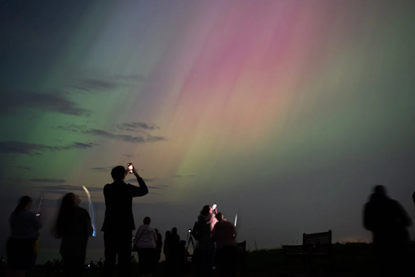
2024年5月10日,人们前往惠特利湾的圣玛莉灯塔观看极光(俗称北极光)。图片来源:Photo by Ian Forsyth/Getty Images
空间天气预报员周三称,一场强烈的太阳风暴正向地球袭来,这可能会在美国应对连续两场飓风之际进一步加剧电网压力。
本周早些时候,美国国家海洋和大气管理局(National Oceanic and Atmospheric Administration)在探测到太阳爆发后,发布了周四至周五的严重磁暴警报。这样的风暴可能会暂时中断电力和无线电信号。
美国国家海洋和大气管理局已通知发电厂和轨道航天器运营商采取预防措施。它还向美国联邦紧急事务管理署(Federal Emergency Management Agency)发出了可能出现电力中断的警告,该机构正在应对飓风“海伦妮”造成的破坏性后果,并为横穿墨西哥湾向佛罗里达州袭来的飓风“米尔顿”做准备。
天气预报员预计此次太阳风暴不会超过今年5月袭击地球的那次太阳风暴,后者是20多年来最强的一次。但只有当它距离地球仅100万英里(160万公里)时,即太空探测器可以对其进行测量时,他们才能确定这一点。
美国国家海洋和大气管理局空间天气预报中心的科学家罗布·斯汀伯格(Rob Steenburgh)说,除非太阳风暴变得更强烈,否则佛罗里达州位于足够南的位置,可以避免太阳风暴造成的电力中断。
斯汀伯格说:“这又让我们更为宽慰一些。我们预测的目的是让他们了解情况,以便做好准备。”
美国国家海洋和大气管理局空间天气预报员肖恩·达尔(Shawn Dahl)说,专家们更担心两周前遭受飓风“海伦妮”袭击地区的电网可能受到的影响。
据美国国家海洋和大气管理局称,这场风暴还可能引发北极光,最南端可达美国中西部南部地区和加利福尼亚北部地区,但具体位置和时间尚不确定。我们提醒天文爱好者者将智能手机对准上方拍照;这些设备通常可以捕捉到人眼无法捕捉到的极光。
五月的太阳风暴在整个北半球产生了耀眼的极光,但没有造成大的干扰。
太阳正处于当前11年周期的高峰期,引发了最近所有的太阳活动。
美联社健康与科学部(The Associated Press Health and Science Department)得到霍华德休斯医学研究所(Howard Hughes Medical Institute)的科学与教育媒体集团的支持。美联社对所有内容全权负责。(财富中文网)
译者:中慧言-王芳
空间天气预报员周三称,一场强烈的太阳风暴正向地球袭来,这可能会在美国应对连续两场飓风之际进一步加剧电网压力。
本周早些时候,美国国家海洋和大气管理局(National Oceanic and Atmospheric Administration)在探测到太阳爆发后,发布了周四至周五的严重磁暴警报。这样的风暴可能会暂时中断电力和无线电信号。
美国国家海洋和大气管理局已通知发电厂和轨道航天器运营商采取预防措施。它还向美国联邦紧急事务管理署(Federal Emergency Management Agency)发出了可能出现电力中断的警告,该机构正在应对飓风“海伦妮”造成的破坏性后果,并为横穿墨西哥湾向佛罗里达州袭来的飓风“米尔顿”做准备。
天气预报员预计此次太阳风暴不会超过今年5月袭击地球的那次太阳风暴,后者是20多年来最强的一次。但只有当它距离地球仅100万英里(160万公里)时,即太空探测器可以对其进行测量时,他们才能确定这一点。
美国国家海洋和大气管理局空间天气预报中心的科学家罗布·斯汀伯格(Rob Steenburgh)说,除非太阳风暴变得更强烈,否则佛罗里达州位于足够南的位置,可以避免太阳风暴造成的电力中断。
斯汀伯格说:“这又让我们更为宽慰一些。我们预测的目的是让他们了解情况,以便做好准备。”
美国国家海洋和大气管理局空间天气预报员肖恩·达尔(Shawn Dahl)说,专家们更担心两周前遭受飓风“海伦妮”袭击地区的电网可能受到的影响。
据美国国家海洋和大气管理局称,这场风暴还可能引发北极光,最南端可达美国中西部南部地区和加利福尼亚北部地区,但具体位置和时间尚不确定。我们提醒天文爱好者者将智能手机对准上方拍照;这些设备通常可以捕捉到人眼无法捕捉到的极光。
五月的太阳风暴在整个北半球产生了耀眼的极光,但没有造成大的干扰。
太阳正处于当前11年周期的高峰期,引发了最近所有的太阳活动。
美联社健康与科学部(The Associated Press Health and Science Department)得到霍华德休斯医学研究所(Howard Hughes Medical Institute)的科学与教育媒体集团的支持。美联社对所有内容全权负责。(财富中文网)
译者:中慧言-王芳
A severe solar storm is headed to Earth that could stress power grids even more as the U.S. deals with major back-to-back hurricanes, space weather forecasters said Wednesday.
The National Oceanic and Atmospheric Administration issued a severe geomagnetic storm watch for Thursday into Friday after an outburst from the sun was detected earlier this week. Such a storm could temporarily disrupt power and radio signals.
NOAA has notified operators of power plants and orbiting spacecraft to take precautions. It also alerted the Federal Emergency Management Agency about possible power disruptions, as the organization copes with the devastating aftermath of Hurricane Helene and gears up for Hurricane Milton barreling across the Gulf of Mexico toward Florida.
Forecasters do not expect the latest solar storm to surpass the one that slammed Earth in May, the strongest in more than two decades. But they won’t know for sure until it’s just 1 million miles (1.6 million kilometers) away, where spacecraft can measure it.
Florida is far enough south to avoid any power disruptions from the solar surge unless it gets a lot bigger, said scientist Rob Steenburgh of NOAA’s Space Weather Prediction Center.
“That adds a little bit more to the comfort level,” Steenburgh said. “Why we’re here is to let them know so that they can prepare.”
Experts are more concerned about potential effects to the power grids in areas slammed by Hurricane Helene two weeks ago, said NOAA space weather forecaster Shawn Dahl.
The storm also may trigger northern lights as far south in the U.S. as the lower Midwest and Northern California, though exact locations and times are uncertain, according to NOAA. Skygazers are reminded to point their smartphones upward for photos; the devices often can capture auroras that human eyes cannot.
May’s solar storm produced dazzling auroras across the Northern Hemisphere and resulted in no major disruptions.
The sun is near the peak of its current 11-year cycle, sparking all the recent solar activity.
___
The Associated Press Health and Science Department receives support from the Howard Hughes Medical Institute’s Science and Educational Media Group. The AP is solely responsible for all content.






